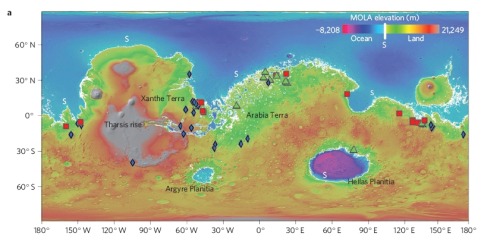Darkchilde wrote:Wrong...
If where comparing notes on basic physics from a surface standpoint, everything you said is true. Solid Material being the most dense with tightly packed molecules. I£ of solid Iron will use the least volume. 1£ of iron liquid will use up more volume. 1£ of iron gas would use significantly more space. 1£ of iron plasma would require the most space.
I'm using Iron as an example, as it's speculated to be one of the primary ingredients of the Earth Cores. As you get closer towards the Earth Center, you are subjecting this material to increasing pressures and stress. I've read about tests on Iron done in controlled labs up to 20GPa and 2000k to get a better understanding of the effects on Fe(iron). The results have shown an increase in vibration measured as sound. With increasing pressure, The molecules heat up and transform into new structures to allow increasing density. In short, the rules are pretty much reversed down inside the earth at extremely high pressures. Solid matter can not handle the threshold of the pressure, and the molecules transfer between atomic packing factors until they are in a liquid state, and then use less volume, with increased density.
Estimates vary but seems the further you go down, obviously more dense the materials get
Continental Crust: 2.7 to 3.0
Oceanic Crust: 3.0 to 3.3
Mantle (silicates): 3.3 to 5.7 (increasing with depth?)
Outer Core (liquid): 9.9 to 12.2
Inner Core (solid): 12.6 to 13.0
Speculation: There is still a lot of speculation and ideas on why the Earth is broken up into all these layers. My idea is that Proto Earth was significantly more dense with a molten surface. As the outer surface cooled, the molecules lost density. As the Earth continues to cool over geological time, the entire planet is transforming from a super dense, to less dense state. As the Mantle transforms into oceanic crust for example, it looses density increasing in volume.
The hotter a substance is the faster its molecules move, so they have more kinetic energy. In order for density to increase you need to do one of the following things:
1. reduce the volume without any change in the mass
2. increase the mass without any change in the volume
3. reduce the volume and increase the mass.
As not to break any rules of thermodynamics, I'm presenting as idea that Material is transforming from a super dense, to less dense state, not increasing in mass, rather volume and density decreases.

Pretty sure I said this before... What if the Inner Core Froze Like Water Into Ice. A solid state would not allow that kind of density, and it might very well expand to allow the density to drop to a solid state. Imagine the entire Earth at a Density of the surface, it would need several times the volume. At that point, I think the inner structure of a planet would look more like our moons.

*Edit* I looked it up and found that new Evidence has come out this year giving us a better understanding of the moons interior. The Crust of the moon is still said to be over 130km thick and one study I've looked at suggests that it's density is pretty uniform through out at 3.3.

Ref: http://news.sciencemag.org/sciencenow/2 ... -seen.html
Ref: http://www.astronomynotes.com/solarsys/s13.htm
As for the rest, I am not going to comment because I think the whole expansion thing is total bollocks. There is no clear mechanism for expansion, no clear mechanism where the extra mass/energy comes from, and I am again repeating myself, with questions that are still unanswered.
Please give me a list of your questions. I'll give you answers based on the best sources on EE Hypothesis.
Re: THWOTH
The reason I kept asking Mr Adams what software he used was to illuminate the suspicion that his animation were a technical realisation of what he imagined the expanding Earth to do.......(picture of Daffy duck in there somewhere... and then something about discs, pyramids and doughnuts)
This has nothing to do with Expanding Earth Hypothesis
Re: Weaver
1) Please provide any evidence whatsoever that Mars was once covered by an ocean - not just depression areas like Hellas, but the whole planet.
Mars Ocean Hypothesis : Good Starting Point http://en.wikipedia.org/wiki/Mars_Ocean_Hypothesis
2) Please provide evidence that the Valles Marinaris is a rift or expansion feature and not the water-carved canyon that most scientists view it to be.
Speculation: We are seeing a rift opening today in Africa that may very well be the Next Atlantic Ocean. Ref http://www.newscientist.com/article/dn1 ... -days.html . While I'm sure everyone will quickly point to subduction to justify any 'expansion' of a new ocean, I would challenge you to point out counter acting subduction zones on Mars. I've looked into the idea, and they don't exist on Mars. Either Mars Expanded to give way to new material forming on the surface... or... Water Erosion.
3) Please define which is important to allow a planet to expand - mass or density?
FFS, I've answered this question 15 times over by now from my perspective, please go back and review
4) Please explain why you continue to believe that EE has any value as a hypothesis, given your admissions that the planet is not currently expanding (as measured by Wu et al) and that there is no change in surface gravity to suggest expansion?
The empirical Evidence of an enclosed upper crust has not been dismissed in my eyes. For that matter, No one here who supports a Static Earth Radius have addressed the peer reviewed paper by Dennis McCarthy on the subject of an enclosed Pacfic. (Not fully true, Ginckgo briefly suggested that it makes sense) Why haven't you or others looked into it? Even if the Earth is not Expanding currently, why is so hard for you to speculate that it may have Expanded in the past?









